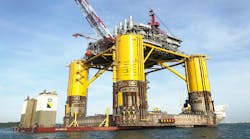As we move into 2013, the future for offshore operations appears to be very bright. This is especially true for operations in the Gulf of Mexico, where some industry reports anticipate booming capital expenditures over the coming years. Thus, from the perspective of the multi-national owner, operator or driller, or from that of the independent supplier and service provider, the potential for renewed offshore operational success is abundantly clear. Yet, as the tumultuous events of the last decade have shown, the risks associated with offshore operations have seemingly never been higher. The recent explosion on Black Elk Energy's West Delta 32 platform serves as a stark reminder of these risks.
Undoubtedly, the past decade's losses have had a profound impact on the offshore insurance markets. The fallout from the April 2010 Macondo well blowout and loss of theDeepwater Horizon is yet to be fully realized. Some estimates have projected losses in excess of $3 billion from this one event alone. Naturally, with losses of that magnitude, the offshore energy industry experienced significant and almost immediate increases in premiums across the board. This is especially true with respect to liability, pollution, and control of well coverage, where some premiums were anticipated to double.
But to say that all offshore energy-related premiums have increased solely as a result of the Macondo well blowout may be painting the picture with too broad a brush. In 2005, Hurricanes Katrina and Rita battered the Gulf of Mexico and resulted in tremendous property damage losses for the offshore energy industry, only to be followed by another significant windstorm event in 2008 in the form of Hurricane Ike. In 2011, both theGryphon and the Banff FPSOs sustained considerable damage due to heavy weather while operating in the North Sea. Business interruption losses from these two events alone are anticipated to surpass $1 billion. Less than one year later, the marine insurance market suffered a significant event in early 2012 with the sinking of the Costa Concordia off the Italian coast.
Armed with the knowledge that premiums will, more than likely, continue to increase as the risks associated with high-pressure, ultra-deepwater operations currently under development also build, many participants may find themselves asking the question: What can be done to manage the costs associated with insurance programs at renewal? Although options for negotiation policies and associated premiums are as diverse as the industry itself, certain strategies may prove beneficial in managing premium costs over the long term.
Know Thine Policies. First, careful attention should be paid to matching the types and nature of policies sought and the coverage granted with the operations at hand. Of course, the necessary coverage will vary for all participants in the offshore energy industry, often from job-to-job, and the premiums associated with each type of coverage will reflect the associated risks.
For the operator, typical insurance needs include the operator's extra expense policy, generally providing coverage control of well, redrilling, seepage and pollution, and third-party and contractual liability coverage. Other policies commonly obtained by operators include loss of production income or business interruption, making wells safe, evacuation, property damage, and construction all risks. For the drilling contractor and offshore service provider, typical policy needs may include protection and indemnity, hull and cargo, maritime employers' liability, comprehensive general liability, umbrella or bumbershoot coverage, and excess coverage. Additional policy needs may again include removal of wreck or debris, loss of occupancy, property damage, and construction all-risk.
Importantly, operating and other agreements may dictate that certain of these policies be obtained by only one participant, but coverage can be extended to others by additional insured requirements. Careful negotiation of the insurance requirements of these agreements can easily result in significant premium savings at all levels by eliminating redundant coverages and allocating risks amongst the parties. Also, recent court decisions defining the types of offshore structures considered "vessels" may necessitate significant changes in coverage going forward.
Demonstrate Preparedness. Second, the ability to demonstrate preparedness to potential underwriters can make or break the renewal process. In August 2012, the Bureau of Safety and Environmental Enforcement released its Final Drilling Safety Rule, which imposes many specific requirements at all levels of offshore participation. Not the least of the requirements is the Spill Response Plan. A complete and well-organized plan, including all statutorily required elements plus additional provisions for training, is persuasive evidence of a coordinated, internal risk management plan when negotiating premiums.
The "Ouch Factor." Third, an understanding of the company's practical ability to meet the deductibles for the policies obtained is of critical importance in managing premiums. Although lower deductibles can reduce the possibility of liquidity issues in the event of a covered occurrence, sharply increased premiums may often outweigh any benefits. For participants with the financial means, self-insuring various defined risks such as property damage may be a viable alternative to manage increased premiums.
Do Not Underestimate the Importance of a Risk Manager. Finally, an experienced risk manager can be a valuable ally at renewal. Not surprisingly, the doors to coverage may be more easily opened to those who can draw on long-term relationships with various underwriters. Additionally, an experienced risk manager can create a beneficial, proactive relationship with underwriters, including facilitating underwriter involvement in the contract negotiations referenced above to ensure proper coverages are obtained.
Daniel D. Pipitone, Chairman, Energy and Maritime Section
Kenneth W. Bullock II, Senior Counsel
Chamberlain, Hrdlicka, White, Williams & Aughtry
Houston, Texas
This page reflects viewpoints on the political, economic, cultural, technological, and environmental issues that shape the future of the petroleum industry. Offshore Magazine invites you to share your thoughts. Email your Beyond the Horizon manuscript to David Paganie at[email protected].




